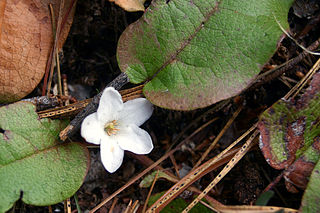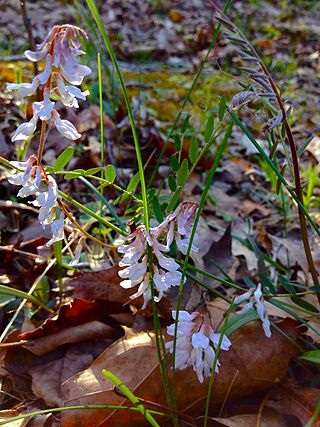Related Research Articles

Acer saccharinum, commonly known as silver maple, creek maple, silverleaf maple, soft maple, large maple, water maple, swamp maple, or white maple, is a species of maple native to the eastern and central United States and southeastern Canada. It is one of the most common trees in the United States.

Ranunculus acris is a species of flowering plant in the family Ranunculaceae, and is one of the more common buttercups across Europe and temperate Eurasia. Common names include meadow buttercup, tall buttercup, common buttercup and giant buttercup.

Epigaea repens, the mayflower, trailing arbutus, or ground laurel, is a low, spreading shrub in the family Ericaceae. It is found from Newfoundland to Florida, west to Kentucky and the Northwest Territories.

Jeffersonia, also known as twinleaf or rheumatism root, is a small genus of herbaceous perennial plants in the family Berberidaceae. They are uncommon spring wildflowers and grow in limestone soils of rich deciduous forests. Jeffersonia was named for United States President Thomas Jefferson by his contemporary Benjamin Smith Barton. This genus was formerly grouped in genus Podophyllum. Twinleaf is protected by state laws as a threatened or endangered plant in Georgia, Iowa, New York, and New Jersey.

Viburnum prunifolium is a species of Viburnum native to eastern North America, from Connecticut west to eastern Kansas, and south to Alabama and Texas.

Senna hebecarpa, with the common names American senna and wild senna, is a species of legume native to eastern North America.

Cardamine diphylla is a plant native to North America.

Liatris spicata, the dense blazing star or prairie feather, is a herbaceous perennial flowering plant in the family Asteraceae. It is native to eastern North America where it grows in moist prairies and sedge meadows.

Viburnum nudum is a deciduous shrub in the genus Viburnum within the muskroot family, Adoxaceae.

Pseudognaphalium obtusifolium is a member of the family Asteraceae, found on open dry sandy habitat throughout Eastern North America. Common names include old field balsam, rabbit tobacco and sweet everlasting. When crushed, the plant exudes a characteristic maple-syrup scent.

Iris virginica, with the common name Virginia blueflag, Virginia iris, great blue flag, or southern blue flag, is a perennial species of flowering plant in the Iridaceae (iris) family, native to central and eastern North America.

Lythrum alatum, commonly known as winged loosestrife, winged lythrum or angled purple-loosestrife, is a species of flowering plant belonging to the family Lythraceae. It is endemic to wetland areas in central and eastern United States and Ontario.

Blephilia hirsuta is an herbaceous perennial of the mint family Lamiaceae native to eastern North America. It is commonly called hairy wood-mint or hairy pagoda plant.

Blephilia ciliata is a species of herbaceous perennial plant in the Lamiaceae (mint) family native to central and eastern North America. It is commonly called downy wood mint. Other common names include downy pagoda-plant, sunny woodmint and Ohio horsemint.
This is a list of plants used by the indigenous people of North America. For lists pertaining specifically to the Cherokee, Iroquois, Navajo, and Zuni, see Cherokee ethnobotany, Iroquois ethnobotany, Navajo ethnobotany, and Zuni ethnobotany.
See also Zuni ethnobotany, and Native American ethnobotany.
This is a list of plants and how they are used in Zuni culture.

Vicia caroliniana, is a plant found in North America.

Lyonia mariana, the Piedmont staggerbush and staggerbush, is a perennial shrub that is native to the United States.

Heteranthera reniformis common name kidneyleaf mud-plantain, and mud plantain; is a plant found in North America. It is listed as a special concern and believed extirpated in Connecticut. It listed as endangered in Illinois and Ohio.
References
- 1 2 Hamel, Paul B. and Mary U. Chiltoskey, 1975, Cherokee Plants and Their Uses – A 400 Year History, Sylva, N.C. Herald Publishing Co., page 62
- ↑ Witthoft, John 1977 Cherokee Indian Use of Potherbs. Journal of Cherokee Studies 2(2):250–255 (p. 251)
- 1 2 Hamel, Paul B. and Mary U. Chiltoskey 1975 Cherokee Plants and Their Uses – A 400 Year History. Sylva, N.C. Herald Publishing Co. (p. 52)
- ↑ Perry, Myra Jean 1975 Food Use of "Wild" Plants by Cherokee Indians. The University of Tennessee, M.S. Thesis (p. 47)
- ↑ Hamel, Paul B. and Mary U. Chiltoskey 1975 Cherokee Plants and Their Uses – A 400 Year History. Sylva, N.C. Herald Publishing Co. (p. 29)
- 1 2 3 4 5 Hamel, Paul B. and Mary U. Chiltoskey 1975 Cherokee Plants and Their Uses – A 400 Year History. Sylva, N.C. Herald Publishing Co. (p. 51, 52)
- ↑ Taylor, Linda Averill 1940 Plants Used As Curatives by Certain Southeastern Tribes. Cambridge, MA. Botanical Museum of Harvard University (p. 61)
- ↑ Hamel, Paul B. and Mary U. Chiltoskey 1975 Cherokee Plants and Their Uses – A 400 Year History. Sylva, N.C. Herald Publishing Co. (p. 24)
- ↑ Hamel, Paul B. and Mary U. Chiltoskey 1975 Cherokee Plants and Their Uses – A 400 Year History. Sylva, N.C. Herald Publishing Co. (p. 58)
- ↑ Hamel, Paul B. and Mary U. Chiltoskey 1975 Cherokee Plants and Their Uses – A 400 Year History. Sylva, N.C. Herald Publishing Co. (p. 59)
- ↑ Taylor, Linda Averill 1940 Plants Used As Curatives by Certain Southeastern Tribes. Cambridge, MA. Botanical Museum of Harvard University (p. 60)
- ↑ Hamel, Paul B. and Mary U. Chiltoskey, 1975, Cherokee Plants and Their Uses -- A 400 Year History, Sylva, N.C. Herald Publishing Co., page 54
- 1 2 Taylor, Linda Averill 1940 Plants Used As Curatives by Certain Southeastern Tribes. Cambridge, MA. Botanical Museum of Harvard University (p. 48)
- 1 2 Hamel, Paul B. and Mary U. Chiltoskey 1975 Cherokee Plants and Their Uses – A 400 Year History. Sylva, N.C. Herald Publishing Co. (p. 23)
- 1 2 3 "Kalmia latifolia". Germplasm Resources Information Network (GRIN). Agricultural Research Service (ARS), United States Department of Agriculture (USDA). Retrieved 2017-12-24.
- ↑ Hamel, Paul B. and Mary U. Chiltoskey 1975 Cherokee Plants and Their Uses – A 400 Year History. Sylva, N.C. Herald Publishing Co. (p. 42)
- ↑ Hamel, Paul B. and Mary U. Chiltoskey, 1975, Cherokee Plants and Their Uses – A 400 Year History, Sylva, N.C. Herald Publishing Co., page 57
- ↑ Broyles, Patrick J. (2004), Blue Wild Indigo (PDF), retrieved 2007-06-19
- ↑ Hamel, Paul B. and Mary U. Chiltoskey, 1975, Cherokee Plants and Their Uses – A 400 Year History, Sylva, N.C. Herald Publishing Co., page 54
- ↑ Hamel, Paul B. and Mary U. Chiltoskey 1975 Cherokee Plants and Their Uses – A 400 Year History. Sylva, N.C. Herald Publishing Co. (p. 60)
- ↑ Taylor, Linda Averill 1940 Plants Used As Curatives by Certain Southeastern Tribes. Cambridge, MA. Botanical Museum of Harvard University (p. 34)
- ↑ Taylor, Linda Averill 1940 Plants Used As Curatives by Certain Southeastern Tribes. Cambridge, MA. Botanical Museum of Harvard University (p. 25)
- 1 2 Hamel, Paul B.; Chiltoskey, Mary U. (1975). Cherokee Plants and Their Uses – A 400 Year History . London: N.C. Herald Publishing Co. p. 41. ISBN 0903505193.
- ↑ Umberto Quattrocchi CRC World Dictionary of Medicinal and Poisonous Plants: Common Names, Scientific names, Synonyms and Etymology , p. 2104, at Google Books
- ↑ Eland, Sue (2008). "Iris cristata" (PDF). plantlives.com. Retrieved 4 April 2015.
- ↑ Hamel, Paul B. and Mary U. Chiltoskey 1975 Cherokee Plants and Their Uses – A 400 Year History. Sylva, N.C. Herald Publishing Co. (p. 41)
- ↑ Lady Bird Johnson Wildflower Center (19 February 2009). "Blephilia ciliata (Downy Pagoda Plant)". University of Texas at Austin. Retrieved 11 December 2011.
- ↑ Hamel and Chiltoskey, Paul B., and Mary U. (1975). Cherokee Plants and Their Uses – A 400 Year History. Sylva, N.C.: Herald Publishing Co. p. 45. Archived from the original on 2013-12-04. Retrieved 2015-05-18.
- ↑ Hamel, Paul B. and Mary U. Chiltoskey, 1975, Cherokee Plants and Their Uses – A 400 Year History, Sylva, N.C. Herald Publishing Co., page 43
- ↑ Perry, Myra Jean, 1975, Food Use of 'Wild' Plants by Cherokee Indians, The University of Tennessee, M.S. Thesis, page 49
- ↑ Hamel, Paul B. and Mary U. Chiltoskey, 1975, Cherokee Plants and Their Uses -- A 400 Year History, Sylva, N.C. Herald Publishing Co., page 45
- 1 2 "Hydrastis canadensis". Germplasm Resources Information Network (GRIN). Agricultural Research Service (ARS), United States Department of Agriculture (USDA). Retrieved 2017-12-24.
- ↑ Prof. Benjamin Smith Barton Collections for an Essay Toward a Materia Medica of the United States (1798, first edition)
- ↑ BSBI List 2007 (xls). Botanical Society of Britain and Ireland. Archived from the original (xls) on 2015-06-26. Retrieved 2014-10-17.
- 1 2 Hamel, Paul B. and Mary U. Chiltoskey 1975 Cherokee Plants and Their Uses – A 400 Year History. Sylva, N.C. Herald Publishing Co. (p. 31)
- ↑ Plants Profile for Agrimonia gyrosepala Retrieved 2010-03-13.
- 1 2 "Agrimonia gryposepala". Germplasm Resources Information Network (GRIN). Agricultural Research Service (ARS), United States Department of Agriculture (USDA). Retrieved 2010-03-13.
- ↑ ITIS Standard Report Page: Agrimonia gryposepala Retrieved 2010-03-13.
- ↑ Daniel E. Moerman (2009). Native American Medicinal Plants: An Ethnobotanical Dictionary . Timber Press. pp. 52–53. ISBN 978-0-88192-987-4.
- 1 2 3 4 5 6 Gabriel, William J. (1990). "Acer saccharinum". In Burns, Russell M.; Honkala, Barbara H. (eds.). Hardwoods. Silvics of North America. Washington, D.C.: United States Forest Service (USFS), United States Department of Agriculture (USDA). Vol. 2 – via Southern Research Station.
- 1 2 Hamel, Paul B. and Mary U. Chiltoskey, 1975, Cherokee Plants and Their Uses -- A 400 Year History, Sylva, N.C. Herald Publishing Co., page 44